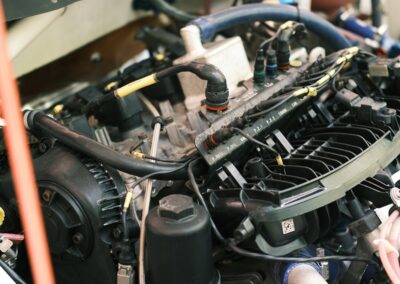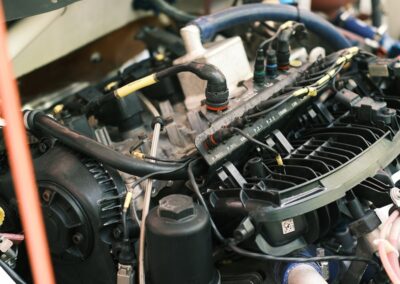The Advantages of IoT-Enabled Predictive Maintenance
Enhancing Equipment Lifespan and Efficiency
In the realm of modern business operations, IoT-enabled predictive maintenance stands out as a revolutionary approach to equipment management. Unlike traditional maintenance practices that often rely on scheduled intervals or reactive measures, IoT-enabled predictive maintenance leverages real-time data and advanced analytics to predict potential equipment failures before they occur. This proactive strategy not only reduces unexpected downtime but also extends the lifespan of critical machinery, significantly impacting business performance.
In dynamic markets such as those in Saudi Arabia and the UAE, where industries like oil and gas, manufacturing, and transportation are vital, the ability to minimize equipment downtime is crucial. IoT sensors and devices monitor various parameters such as temperature, vibration, and pressure, sending real-time data to centralized systems. By analyzing this data with sophisticated algorithms, businesses can identify patterns and anomalies that indicate potential failures. For instance, in a manufacturing plant in Riyadh, IoT-enabled systems can predict when a machine part might fail, allowing for timely interventions and reducing the risk of production halts.
Moreover, extending the lifespan of equipment through predictive maintenance can lead to substantial cost savings. Traditional maintenance practices, such as periodic overhauls or repairs, often involve replacing parts based on estimated lifespans or after a breakdown has occurred. In contrast, predictive maintenance optimizes part replacement and repairs based on actual wear and tear data. This data-driven approach ensures that components are only replaced when necessary, thereby extending their operational life and reducing overall maintenance expenses.
Reducing Downtime and Operational Disruptions
One of the most compelling benefits of IoT-enabled predictive maintenance is its ability to significantly reduce operational disruptions caused by unexpected equipment failures. Traditional maintenance strategies, such as reactive maintenance, often result in unplanned downtime that can disrupt production schedules and lead to costly delays. By contrast, predictive maintenance utilizes real-time data to anticipate equipment issues and schedule maintenance activities during planned downtime or off-peak hours, minimizing the impact on overall operations.
In a bustling metropolis like Dubai, where industries are continuously evolving and expanding, maintaining seamless operations is essential. IoT-enabled predictive maintenance enables businesses to transition from reactive to proactive maintenance strategies, allowing them to plan and execute maintenance tasks more effectively. For example, in the construction sector, where machinery and equipment are critical to project timelines, predictive maintenance ensures that potential issues are addressed before they lead to costly project delays.
Furthermore, predictive maintenance contributes to a more efficient use of resources. Instead of relying on fixed maintenance schedules that may or may not align with the actual condition of the equipment, businesses can perform maintenance activities precisely when needed. This targeted approach reduces the frequency of unnecessary maintenance tasks and optimizes the allocation of maintenance resources, leading to better overall equipment utilization and lower operational costs.
Implementing IoT-Enabled Predictive Maintenance Strategies
Integrating Advanced Technologies and Data Analytics
Implementing IoT-enabled predictive maintenance requires a strategic approach that integrates advanced technologies and data analytics. To effectively leverage the benefits of predictive maintenance, businesses must invest in IoT sensors, data collection systems, and analytics platforms that can process and interpret the data generated by connected devices. This integration enables a comprehensive view of equipment health and performance, facilitating informed decision-making and timely maintenance actions.
In Saudi Arabia’s energy sector, for instance, integrating predictive maintenance technologies can enhance the reliability of critical infrastructure such as pipelines and drilling equipment. IoT sensors installed on equipment can continuously monitor operational parameters and transmit data to a centralized analytics platform. Machine learning algorithms analyze this data to identify early signs of potential failures, allowing maintenance teams to address issues proactively and prevent costly operational disruptions.
Additionally, businesses must establish a robust data management framework to support predictive maintenance efforts. This includes ensuring data accuracy, security, and accessibility. With a solid data management strategy, companies can effectively utilize predictive maintenance insights to optimize maintenance schedules, improve equipment performance, and enhance overall operational efficiency.
Challenges and Best Practices for Successful Implementation
While IoT-enabled predictive maintenance offers numerous benefits, successful implementation requires addressing several challenges and adhering to best practices. One of the primary challenges is the integration of IoT systems with existing equipment and infrastructure. Businesses must ensure that their IoT solutions are compatible with current systems and can effectively collect and analyze data from various sources.
In Dubai’s bustling hospitality and tourism sector, where maintaining high service standards is crucial, integrating predictive maintenance systems with existing operational frameworks can be complex. Best practices for overcoming these challenges include conducting a thorough assessment of current equipment and infrastructure, selecting compatible IoT technologies, and collaborating with experienced technology providers to ensure seamless integration.
Another important consideration is ensuring that maintenance staff are adequately trained to utilize predictive maintenance tools and interpret data insights. Providing training and support for staff members ensures that they can effectively leverage the benefits of predictive maintenance and make informed decisions based on real-time data. Regular training sessions and ongoing support are essential for maximizing the impact of predictive maintenance initiatives and achieving long-term success.
In conclusion, IoT-enabled predictive maintenance represents a transformative approach to equipment management, offering significant advantages over traditional maintenance practices. By leveraging real-time data and advanced analytics, businesses can reduce downtime, extend equipment lifespan, and optimize resource utilization. In dynamic markets such as Saudi Arabia and the UAE, where operational efficiency and cost-effectiveness are crucial, implementing predictive maintenance strategies can provide a competitive edge and drive business success.
—
#IoTEnabledPredictiveMaintenance #PredictiveMaintenanceBenefits #IoTEquipmentLongevity #SmartMaintenanceSolutions #SaudiArabia #UAE #Riyadh #Dubai #TechnologyIntegration































